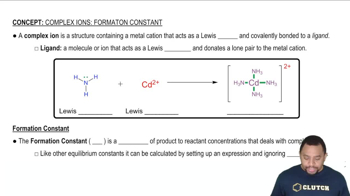Here are the essential concepts you must grasp in order to answer the question correctly.
Solubility Product Constant (Ksp)
The solubility product constant (Ksp) is an equilibrium constant that applies to the solubility of sparingly soluble ionic compounds. It represents the maximum concentration of ions that can exist in a saturated solution at a given temperature. For a compound like NiC2O4, Ksp is calculated from the concentrations of its dissociated ions, and a low Ksp value indicates very low solubility.
Recommended video:
Solubility Product Constant
Formation Constant (Kf)
The formation constant (Kf) quantifies the stability of a complex ion formed in solution. It is the equilibrium constant for the formation of a complex from its constituent ions. In this context, NH3 can form a complex with Ni^2+, which significantly affects the solubility of NiC2O4 by reducing the concentration of free Ni^2+ ions in solution, thus allowing more of the salt to dissolve.
Recommended video:
Complex Ions and Formation Constant
Le Chatelier's Principle
Le Chatelier's Principle states that if a system at equilibrium is subjected to a change in concentration, temperature, or pressure, the system will adjust to counteract that change and restore a new equilibrium. In this scenario, adding NH3 shifts the equilibrium towards dissolving more NiC2O4 by reducing the concentration of Ni^2+ ions, thereby allowing more of the salt to dissolve in the solution.
Recommended video:
 Verified step by step guidance
Verified step by step guidance

